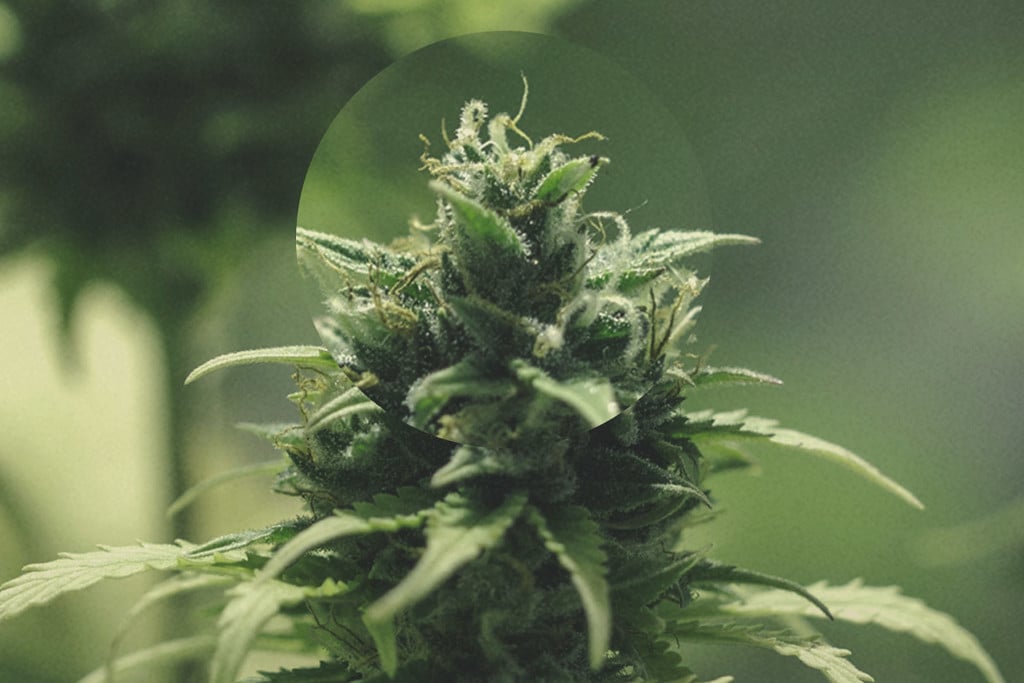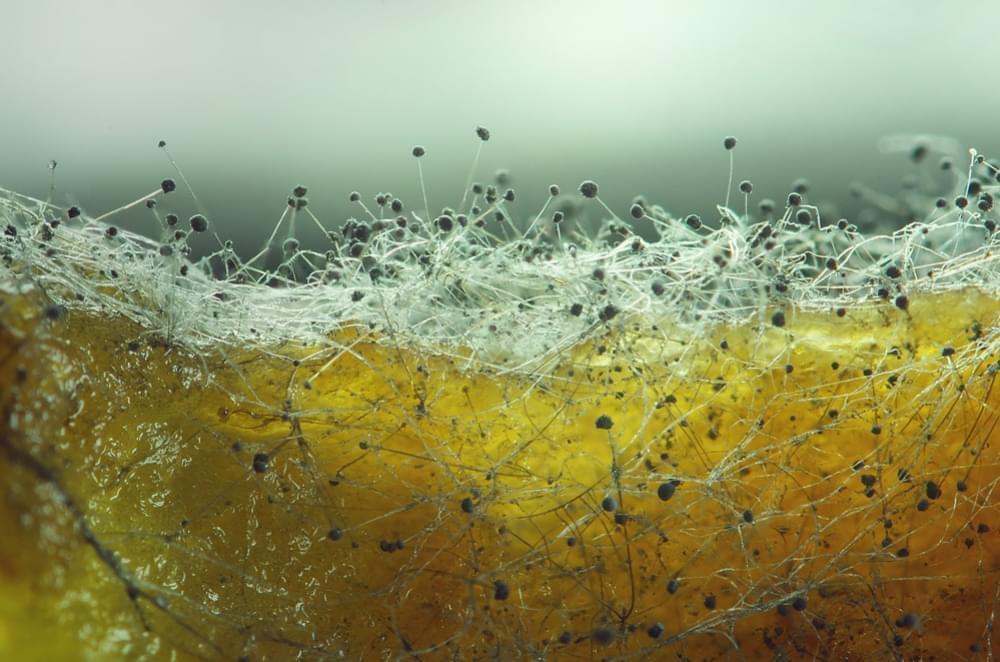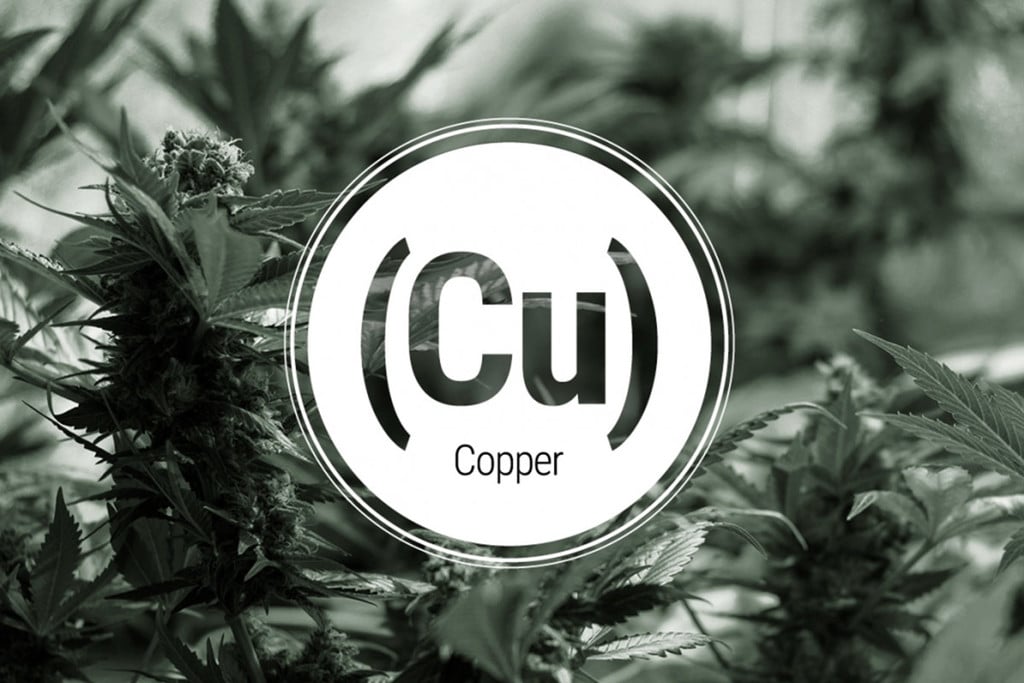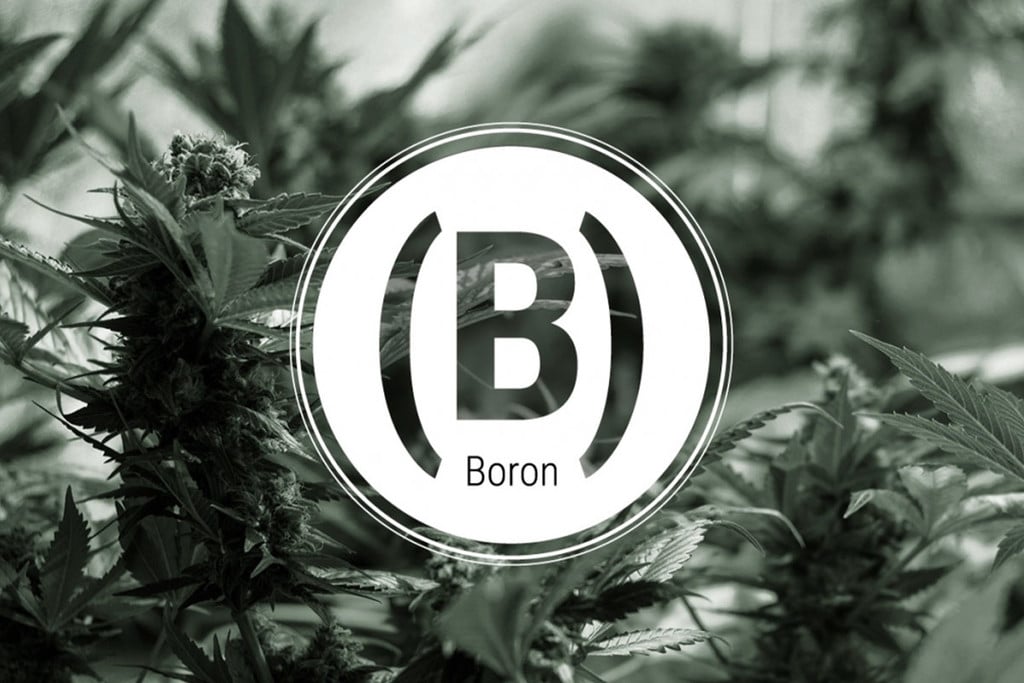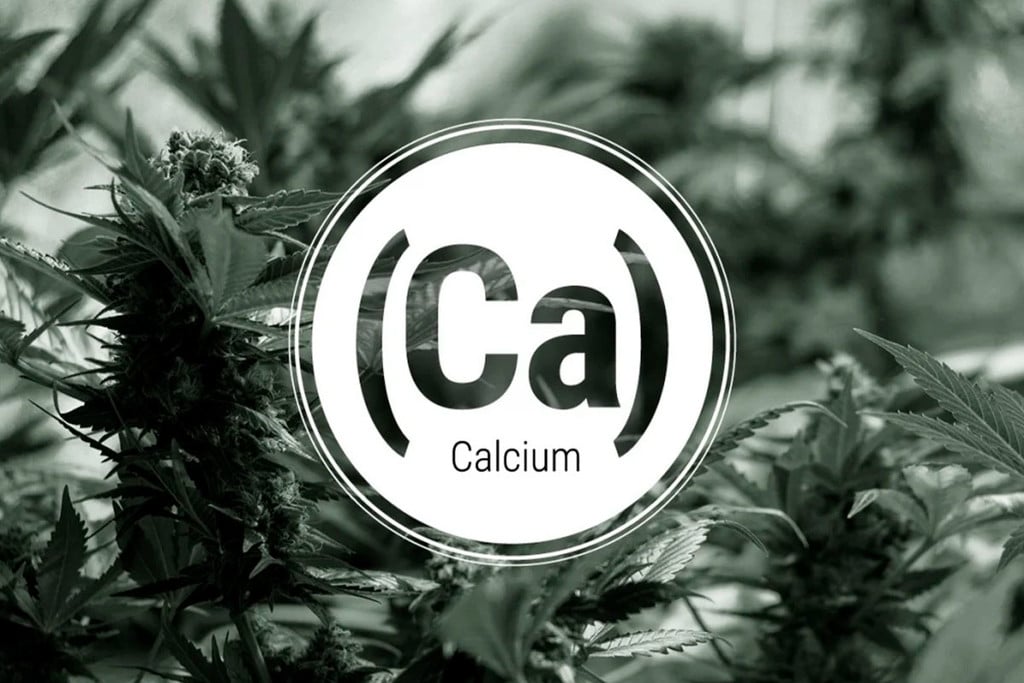 Weed Grow Guide by Royal Queen Seeds
Weed Grow Guide by Royal Queen Seeds
- Growing weed step by step
- Cannabis growing basics
- Choosing your seeds
- How to germinate seeds
- The cannabis vegetative stage
- The cannabis flowering stage
- Harvesting cannabis
- Trimming, drying, and curing
- Choosing pots and soil
-
Growing indoors
- A Complete Overview Of Growing Cannabis Indoors
- Cannabis Cultivation Tips: How To Set Up Indoor Grow Lights
- How Many Cannabis Plants Can You Grow Per Square Metre?
- Indoor Cannabis Growing: Relative Humidity and Temperatures
- Hydroponics Cannabis Growing Guide (with diagrams)
- Cannabis Micro Growing: Growing Great Weed in Tiny Spaces
- Growing outdoors
- How to grow autoflowering cannabis
- Cannabis nutrients and pH
- Cannabis troubleshooting: Nutrients
-
Cannabis troubleshooting: Growing
- Cannabis Seed Germination — Troubleshooting Guide
- How to Deal With Pythium (Root Rot) in Cannabis Plants
- Slow Cannabis Plant Growth And What You Can Do About It
- How to Deal With Leggy Cannabis Seedlings
- Watering Your Cannabis: How to Fix Overwatering and Underwatering
- Understanding Male, Female, And Hermaphrodite Cannabis
- Identifying and Treating Common Cannabis Ailments
- How To Revive a Sick Cannabis Plant
- How to Avoid Mouldy Weed During Drying and Curing
- How to Prevent and Treat Dry and Crispy Cannabis Leaves
- What Cannabis Leaves Can Tell You
- Causes and Solutions for Yellow Cannabis Leaves
-
Cannabis Strains Grow Report
- HulkBerry Automatic Grow Report
- Blue Cheese Auto Grow Report
- Purple Punch Automatic Strain Grow Report
- Triple G Automatic Grow Report
- Do-Si-Dos Automatic Grow Report
- Green Gelato Automatic Grow Report
- Haze Berry Automatic Grow Report
- Purple Queen Automatic Grow Report
- Cookies Gelato Automatic Grow Report
- Sherbet Queen Automatic Grow Report
- Sweet Skunk Automatic Grow Report
- Medusa F1 Grow Report
- Cannabis plant training
-
Weed growing tips
- The Cannabis Plant Anatomy
- How to preserve seeds - UK
- How Much Sunlight Do Outdoor Cannabis Plants Need To Grow?
- How to Control and Prevent Stretching in Cannabis Plants
- My Cannabis Plants Are Growing Too Tall: What Should I Do?
- Should You Worry About Purple Or Red Cannabis Stems?
- What To Do When Your Indoor Cannabis Won’t Flower
- How To Protect Your Cannabis Plants From Heat Stress
- How To Tell If Your Female Cannabis Plant Has Been Pollinated
- Growing Medical Marijuana
- Bud Washing: How to Clean Your Weed
- Understanding Cannabis Yield per Plant
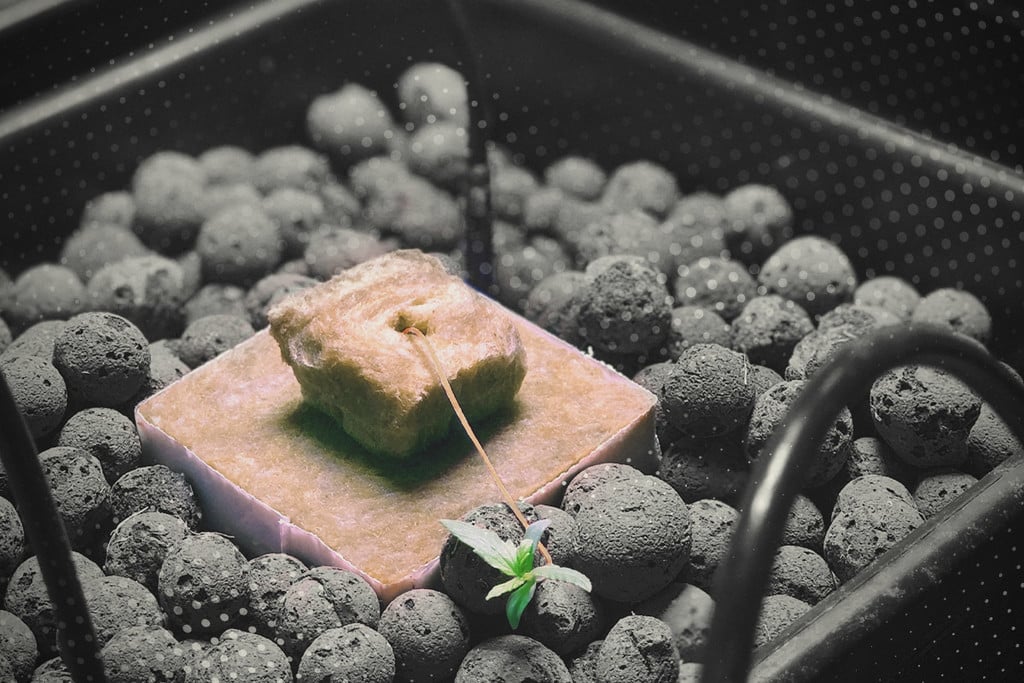
How to Deal With Pythium (Root Rot) in Cannabis Plants
Pythium species are a big threat to cannabis plant health. When conditions are right, these strange parasitic organisms strike the roots of plants, causing rotting in this key anatomical location.
Sometimes, raising a strong and healthy flowering cannabis plant from a seedling seems effortless. Other times, things don’t go to plan. A range of factors can cause challenges to arise, including biotic stressors such as pest infestations and pathogens. The latter are particularly threatening, especially those that go undetected in the subterranean domain of the rhizosphere.
Despite having a two-branched innate immune system capable of neutralising some pathogens, and an entourage of beneficial microbes to help fight off the bad guys, cannabis plants still often fall prey to diseases. Among these microbial foes, Pythium species rank as some of the most destructive root pathogens. Neither a fungus nor a bacterium, members of this genus belong to the phylum Oomycota—fungi-like organisms that differ in their sexual reproduction, cell well composition, and genetic components.
These pathogens cause a range of symptoms, including “damping off”, which affects seedlings and can end a grow before it even gets started. Below, you'll learn everything you need to know about Pythium, how to deal with it when it strikes, and how to prevent it from infecting plants in the first place.
Contents:
What Is Pythium (Root Rot)?
Members of the Pythium genus are plant pathogens that wreak havoc in agricultural settings, from large field operations to small home setups. Researchers have identified over 100 species within the genus. Originally considered fungal pathogens, scientists eventually categorised Pythium as parasitic Oomycetes due to genetic, sexual, and structural differences.
Pythium species exist in the soil as fungi-like mycelial networks that possess both sexual and asexual structures. From here, they produce two types of spores that go on to affect plants: zoospores and oospores. Sexual reproduction leads to the creation of oospores. These thick-walled spores can directly infect plants, or form a vesicle that they flood with cytoplasm. Eventually, the vesicle fills with zoospores equipped with flagellum—small tails that they use to propel themselves through standing water and saturated soil. Zoospores are created asexually in structures called sporangium.
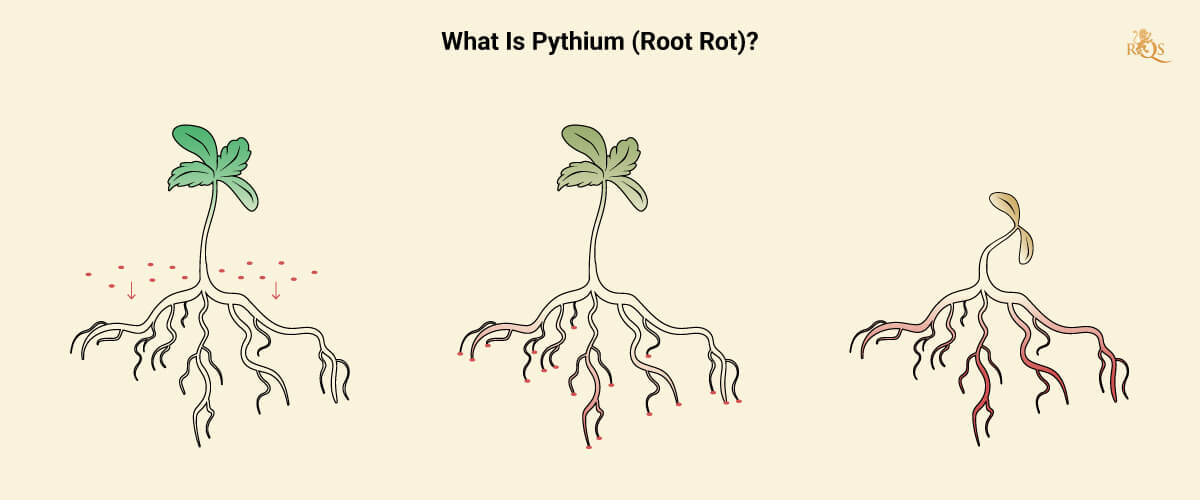
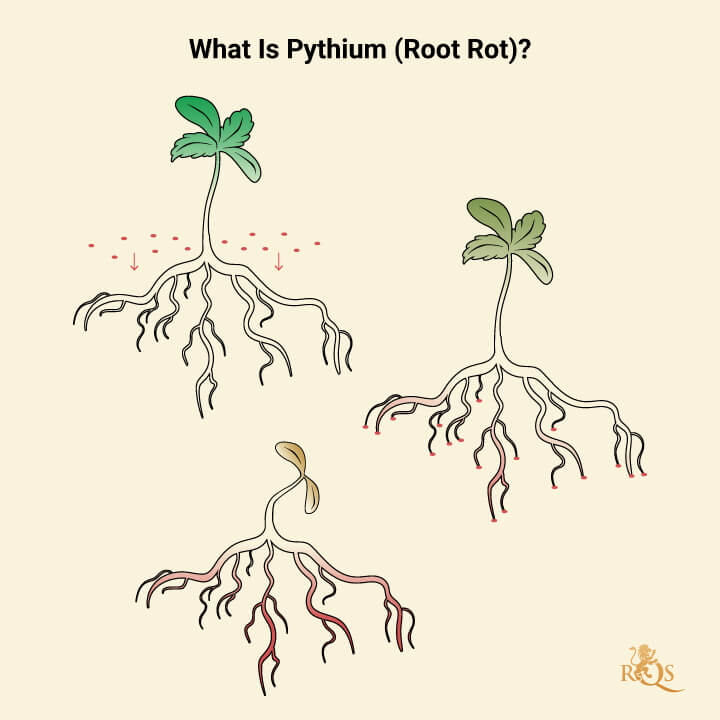
Upon release, swimming zoospores are attracted to the sugary exudates that plant roots release into the soil to attract beneficial microbes. After following the trail, they attach themselves near the tip of the roots and form a hard cell wall. From here, they release a thread-like structure known as a hypha, which uses enzymes to bust through the cell walls of epidermal root cells.
The hyphae start to branch out and colonise the cells of the root cortex (the outer layer of cells), eventually causing this structure to become unstable and collapse. The root cortex holds the vital root hairs that plants use to uptake water and nutrients, which means Pythium-infected plants are cut off from the resources they need to survive. Pythium species also cause lesions that other root pathogens use as a point of entry.
What Causes Pythium Infection?
As opportunistic water molds, Pythium species cause root rot when environmental factors allow them to gain a foothold. They strike when plants are weakened or damaged, which also means plant immunity and vitality are compromised.
Overwatering creates an ideal anaerobic environment for Pythium species to thrive. Saturated soil allows zoospores to easily move around and trace exudates to plant roots. A lack of oxygen in the root zone can also suffocate roots, causing cell death and easier entry for zoospores. Excess water can also attract pests, such as fungus gnats, that will attack and weaken the root cortex.
The ultimate cause of root rot from Pythium is the introduction of the pathogen into a growing space. Outdoors, plants are much more likely to encounter this pathogen. Indoors, growers can take steps to keep plants isolated. Pythium species can make their way into a growing space via infected plants, contaminated equipment, or clothes.
Can Root Rot Spread to Other Cannabis Plants?
Yes. Pythium species have several effective means of ensuring their survival as parasites. First, after conquering the root cortex of one plant, they will continue to obtain resources and reproduce both sexually and asexually. The continued release of increasing amounts of zoospores sees progeny venture out into the soil in search of other exudate sources.
The sexual production of oospores also leaves long-term genetic deposits in the soil; these structures lay dormant in the winter, ready to strike young seedlings the following spring. Pythium zoospores and oospores can spread through several vectors, including hydroponic solutions and contaminated soil.
What Pythium (Root Rot) Looks Like
Rot induced by Pythium manifests in several obvious ways. Keep an eye out for these key root rot symptoms:
🟡 Root color: Roots appear darker in color. Rather than the usual white, they’ll take on shades of beige, yellow, and brown.
🌫️ Root texture: Plant roots are relatively firm. Following root rot, they’ll become soft, mushy, and sticky due to the structural changes resulting from root cortex damage.
🦨 Root smell: Pythium infections often take place in anaerobic conditions. Because of this, both the rotten roots and growing medium will emit an unpleasant odour.
🥀 Damping off: Young seedlings will rapidly lose vitality and completely collapse not long after shoots emerge from the soil.
📉 Stunting: You’ll notice older, more established plants start to underperform. Their rate of growth will slow down considerably.
🕸️ Crown rot: You’ll notice browning at the top of the roots and the lower portion of the main stem as the pathogen starts to infect cells higher up the plant.
🍂 Chlorosis: Due to compromised nitrogen uptake following root cortex damage, fan leaves will start to become yellow.
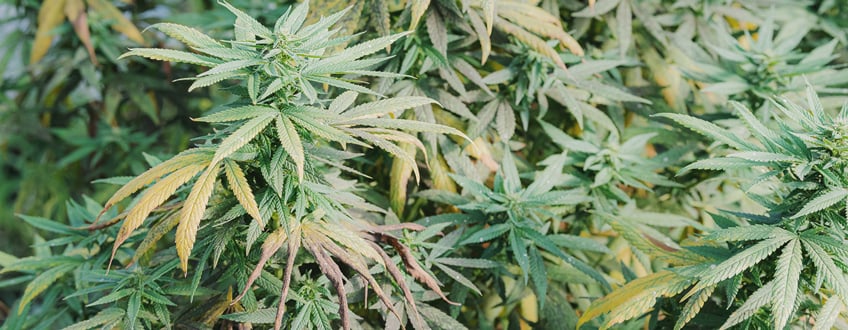
Can Root Rot Be Reversed?
No cure for Pythium root rot exists at this time. However, you shouldn’t just let your plant die and give up without investigating further. Securing a diagnosis will help you plan ahead in more ways than one.
If you grow outdoors directly in the ground, you’ll need to make sure you avoid the same patch next year. Growing in the same soil shortly afterward will result in the same outcome.
If you breed cannabis, look out for plants that display resistance to the infection. Taking a cutting and growing it in an isolated spot could mean securing some highly resistant genetics.
How to Treat Pythium (Root Rot)
You can’t treat weed plants infected with Pythium. Unfortunately, you’ll need to cull any affected specimens immediately to minimise pathogenic spread to other areas of your garden or growing space. If you can, throw them onto a fire; placing them into your compost bin could contaminate your crop with oospores next season.
Though you can’t treat your plants, you can treat your growing medium. There are several chemical options growers can use to get the job done. If, however, you prefer to keep things organic, below are some steps you can take.
- First, remove any plants from the area and burn them. Avoid planting anything in the area for a couple of seasons; you don’t want to provide latent oospores with a food source.
- Next, brew up a strong batch of compost tea. Early research suggests that both aerated and non-aerated compost tea can help to inhibit the mycelial growth of certain Pythium species. These preparations use inoculants to rapidly produce large numbers of beneficial microbes, including fungi, bacteria, protozoa, and nematodes. Upon application, these organisms increase the biodiversity in the soil and compete with pathogens.
- Apply liberally during spring and fall over the next couple of seasons to rebalance the soil microbiome in affected cultivation areas.
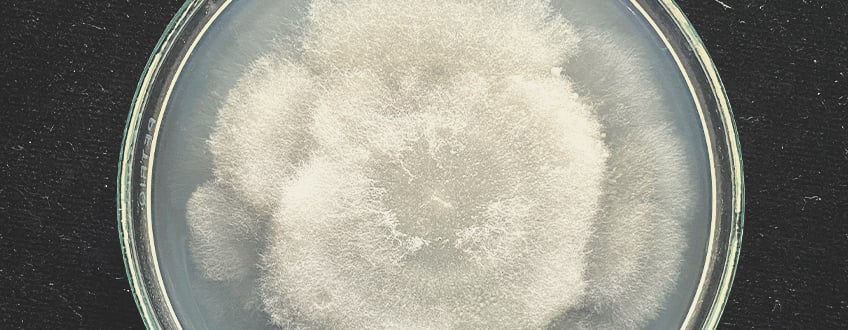
Root Rot and Hydroponic Systems
Fortunately, hydroponic systems are much easier to clean than patches of soil out in the garden. If your hydro plants exhibit signs of cannabis stem rot and unhealthy root browning, you can simply scrub everything down and start from square one. Pour all of the nutrient solution in your system directly down a drain; avoid pouring it into your garden.
Whip up a 3% hydrogen peroxide solution, and wipe down the inside of your grow tent and your entire hydroponics system with a soft sponge. Cover every square inch of your reservoir and any external grow trays. Dunk smaller pipes into buckets containing the solution, and replace any components that are too small or tricky to clean thoroughly.
How to Prevent Pythium (Root Rot)
There are several ways growers can go about preventing Pythium from gaining a foothold in the garden or grow room. None of these are magic bullets, but they can significantly minimise the chances of an infestation. These strategies include:
- Symbiotic fungi: Species of arbuscular mycorrhizal fungi fuse to cannabis plant roots and form a symbiotic relationship. They help to obtain nutrients and water for plants, and receive exudates in return. These organisms may also help to defend against certain Pythium species[1]. Apply spores or propagules when sowing seeds or transplanting seedlings.
- Trichoderma: Members of this genus of soil fungi can help to fight off Pythium species in the root zone. Apply Trichoderma to seeds and as a soil amendment to reduce the chances of infection.
- Proper watering: To reduce the chances of root rot, you need to learn how to water cannabis plants properly. Wait until the top inch of the growing medium becomes completely dry before watering again. Maintaining a proper wet–dry cycle will help to avoid the anaerobic conditions that drive infection.
- Optimal dissolved oxygen (hydroponics): Reduced dissolved oxygen in a hydroponics system can increase the chances of cannabis root rot. To increase dissolved oxygen content, use techniques such as fluming and electrolysis.
- General hygiene: Don’t help Pythium species get established in the first place. To avoid acting as a transmission vector, clean your equipment and change out dirty clothes before entering your growing space. Dedicate growing gear specifically to indoor or outdoor plants; never bring dirty containers and watering cans into your grow tent, or vice versa.
- Restructure your soil: Create a growing medium with adequate drainage and aeration by adding organic matter, high-quality compost, perlite, and small amounts of sand.
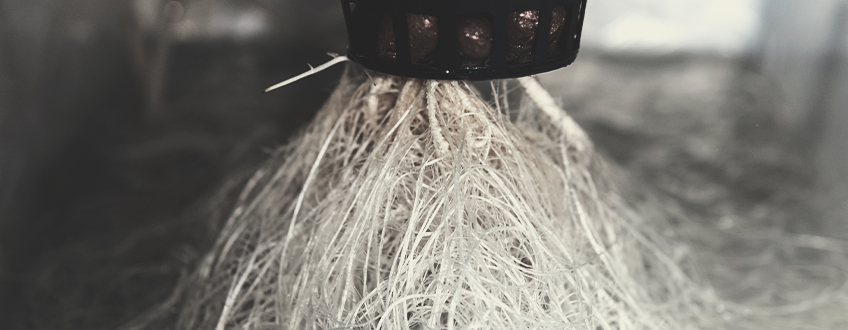
Will Pythium Go Away on Its Own?
No. You should take an active approach to purge Pythium and prevent root rot in the future. Indoor hydroponic growers have the advantage here, as they can simply clean and disinfect their grow space and cultivation gear.
Outdoors, you’ll need to play the long game. These steps should help to remediate your soil over time:
- Burn all infected plant material.
- Do not plant in the affected spot next season.
- Dig organic matter, sand, and perlite into the medium to increase aeration.
- Apply liberal quantities of aerated and non-aerated compost tea to the site.
- After 1–2 seasons, apply Trichoderma and arbuscular mycorrhizal spores to seedlings before transplanting.
Even if you find yourself facing cannabis pathogens, you should still look on the bright side! Dealing with Pythium once will force you to learn more about soil biology and ultimately become a wiser and more prepared cannabis grower in the long run.
- Effect of arbuscular mycorrhizal fungi on Pythium aphanidermatum causing foot rot disease on pawpaw (Carica papaya L.) seedlings https://www.tandfonline.com
 Grow Guide Topic Finder
Grow Guide Topic Finder
- Growing weed step by step
- Cannabis growing basics
- Choosing your seeds
- How to germinate seeds
- The cannabis vegetative stage
- The cannabis flowering stage
- Harvesting cannabis
- Trimming, drying, and curing
- Choosing pots and soil
-
Growing indoors
- A Complete Overview Of Growing Cannabis Indoors
- Cannabis Cultivation Tips: How To Set Up Indoor Grow Lights
- How Many Cannabis Plants Can You Grow Per Square Metre?
- Indoor Cannabis Growing: Relative Humidity and Temperatures
- Hydroponics Cannabis Growing Guide (with diagrams)
- Cannabis Micro Growing: Growing Great Weed in Tiny Spaces
- Growing outdoors
- How to grow autoflowering cannabis
- Cannabis nutrients and pH
- Cannabis troubleshooting: Nutrients
-
Cannabis troubleshooting: Growing
- Cannabis Seed Germination — Troubleshooting Guide
- How to Deal With Pythium (Root Rot) in Cannabis Plants
- Slow Cannabis Plant Growth And What You Can Do About It
- How to Deal With Leggy Cannabis Seedlings
- Watering Your Cannabis: How to Fix Overwatering and Underwatering
- Understanding Male, Female, And Hermaphrodite Cannabis
- Identifying and Treating Common Cannabis Ailments
- How To Revive a Sick Cannabis Plant
- How to Avoid Mouldy Weed During Drying and Curing
- How to Prevent and Treat Dry and Crispy Cannabis Leaves
- What Cannabis Leaves Can Tell You
- Causes and Solutions for Yellow Cannabis Leaves
-
Cannabis Strains Grow Report
- HulkBerry Automatic Grow Report
- Blue Cheese Auto Grow Report
- Purple Punch Automatic Strain Grow Report
- Triple G Automatic Grow Report
- Do-Si-Dos Automatic Grow Report
- Green Gelato Automatic Grow Report
- Haze Berry Automatic Grow Report
- Purple Queen Automatic Grow Report
- Cookies Gelato Automatic Grow Report
- Sherbet Queen Automatic Grow Report
- Sweet Skunk Automatic Grow Report
- Medusa F1 Grow Report
- Cannabis plant training
-
Weed growing tips
- The Cannabis Plant Anatomy
- How to preserve seeds - UK
- How Much Sunlight Do Outdoor Cannabis Plants Need To Grow?
- How to Control and Prevent Stretching in Cannabis Plants
- My Cannabis Plants Are Growing Too Tall: What Should I Do?
- Should You Worry About Purple Or Red Cannabis Stems?
- What To Do When Your Indoor Cannabis Won’t Flower
- How To Protect Your Cannabis Plants From Heat Stress
- How To Tell If Your Female Cannabis Plant Has Been Pollinated
- Growing Medical Marijuana
- Bud Washing: How to Clean Your Weed
- Understanding Cannabis Yield per Plant


























